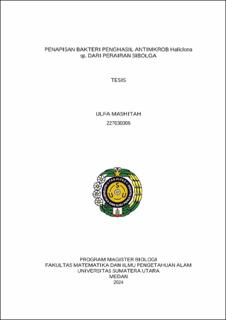Penapisan Bakteri Penghasil Antimkrob Haliclona sp. dari Perairan Sibolga
| dc.contributor.advisor | Suryanto, Dwi | |
| dc.contributor.advisor | Nurtjahja, Kiki | |
| dc.contributor.author | Mashitah, Ulfa | |
| dc.date.accessioned | 2025-05-23T08:00:37Z | |
| dc.date.available | 2025-05-23T08:00:37Z | |
| dc.date.issued | 2024 | |
| dc.identifier.uri | https://repositori.usu.ac.id/handle/123456789/104084 | |
| dc.description.abstract | Sponges are hosts to various types of microbes capable of producing antimicrobials. This research aims to identify and test the antibacterial activity of the sponge Haliclona sp. against human pathogenic microbes resistant to various drugs. Through antagonistic tests, methanol and ethyl acetate extracts from the symbiotic bacteria of Haliclona sp. showed significant antibacterial activity against Staphylococcus aureus, Vibrio parahaemolyticus, and Candida albicans. The methanol extract contains 49 active compounds, including Pyrrolo[1,2-a]pyrazine-1,4-dione, cis-Vaccenic acid, and 10E,12Z-Octadecadienoic acid, while the ethyl acetate extract contains 29 active compounds, with Pyrrolo[1,2-a]pyrazine-1,4-dione and 2,4-Imidazolidinedione as the dominant compounds. Genotypic identification revealed that isolate Sp510-1(4) has 76% homology with Ornithibacillus sp. | en_US |
| dc.language.iso | id | en_US |
| dc.publisher | Universitas Sumatera Utara | en_US |
| dc.subject | Haliclona sp. | en_US |
| dc.subject | Marine sponge | en_US |
| dc.subject | Symbiotic bacteria | en_US |
| dc.subject | Antimicrobial | en_US |
| dc.title | Penapisan Bakteri Penghasil Antimkrob Haliclona sp. dari Perairan Sibolga | en_US |
| dc.title.alternative | Screening of Antimicrobial Producing Bacteria Haliclona sp. from Sibolga Waters | en_US |
| dc.type | Thesis | en_US |
| dc.identifier.nim | NIM227030006 | |
| dc.identifier.nidn | NIDN0009046404 | |
| dc.identifier.nidn | NIDN0011126204 | |
| dc.identifier.kodeprodi | KODEPRODI46101#Biologi | |
| dc.description.pages | 60 Pages | en_US |
| dc.description.type | Tesis Magister | en_US |
| dc.subject.sdgs | SDGs 14. Life Below Water | en_US |
Files in this item
This item appears in the following Collection(s)
-
Master Theses [261]
Tesis Magister


